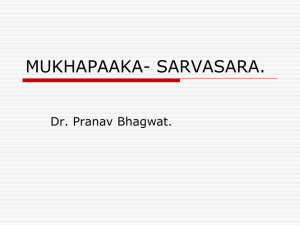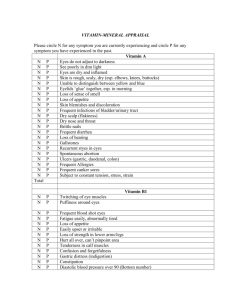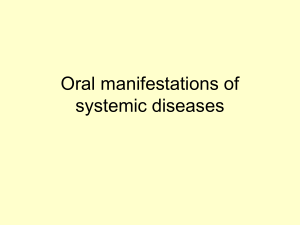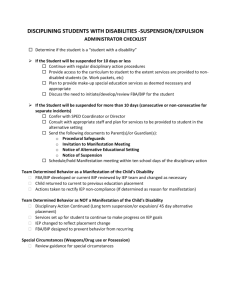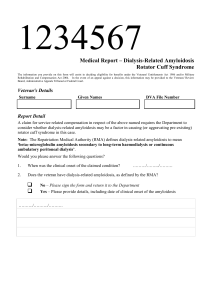ORAL MANIFESTATION OF SYSTEMIC DISEASE
advertisement
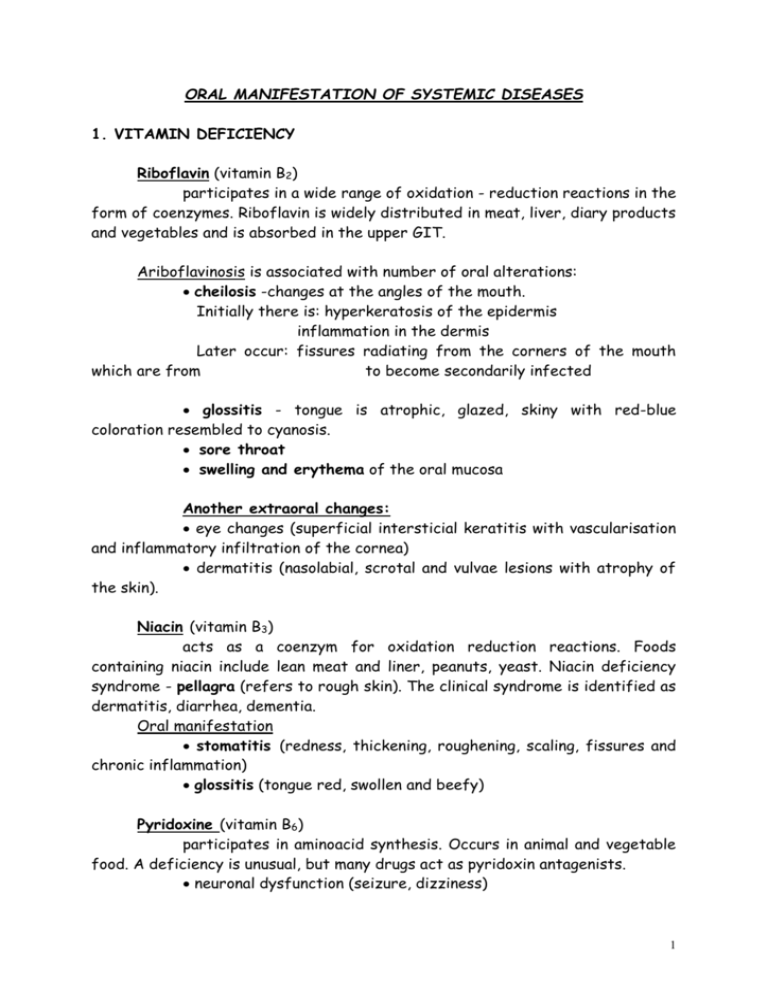
ORAL MANIFESTATION OF SYSTEMIC DISEASES 1. VITAMIN DEFICIENCY Riboflavin (vitamin B2) participates in a wide range of oxidation - reduction reactions in the form of coenzymes. Riboflavin is widely distributed in meat, liver, diary products and vegetables and is absorbed in the upper GIT. Ariboflavinosis is associated with number of oral alterations: cheilosis -changes at the angles of the mouth. Initially there is: hyperkeratosis of the epidermis inflammation in the dermis Later occur: fissures radiating from the corners of the mouth which are from to become secondarily infected glossitis - tongue is atrophic, glazed, skiny with red-blue coloration resembled to cyanosis. sore throat swelling and erythema of the oral mucosa Another extraoral changes: eye changes (superficial intersticial keratitis with vascularisation and inflammatory infiltration of the cornea) dermatitis (nasolabial, scrotal and vulvae lesions with atrophy of the skin). Niacin (vitamin B3) acts as a coenzym for oxidation reduction reactions. Foods containing niacin include lean meat and liner, peanuts, yeast. Niacin deficiency syndrome - pellagra (refers to rough skin). The clinical syndrome is identified as dermatitis, diarrhea, dementia. Oral manifestation stomatitis (redness, thickening, roughening, scaling, fissures and chronic inflammation) glossitis (tongue red, swollen and beefy) Pyridoxine (vitamin B6) participates in aminoacid synthesis. Occurs in animal and vegetable food. A deficiency is unusual, but many drugs act as pyridoxin antagenists. neuronal dysfunction (seizure, dizziness) 1 cheilitis glossitis (simular to pellagra) Vitamin C necessary for the proper synthesis of collagen. Occurs mainly in citrus fruits. A deficiency is known as Scurvy-occurs in the growing child and erderly men. -hemorhage (purpura and ecchymoses of skin and gingival mucosa, subperiostal hematomas. -skeletal changes in infants and children (disturbance in the formation of osteoid matrix) Oral manifestation: gingival swelling with spontaneous hemorrhage, ulceration, tooth mobility, secondary periodontal infection and periodontal bone loss. The gingival lesions are called scorbutic gingivitis. Wound healing and localisation of focal infections are impaired because of the dearangement of collagen synthesis. Vitamin K a deficiency or inhibition of syntheses of vitamin K leads to coagulopathy (inadequate synthesis of prothrombin and other clotting factors). Intraoral changes: gingival bleeding 2. ANEMIAS A: Iron-deficiency anemia may results from - low dietary intake of iron (vegetarian diet etc.) - decreased absorption of iron (melabsorption) - increated demands (pregnancy, infancy) - chronic blood loss GIT - peptic ulcer,colonic cancer etc. female genital tract- metrorrhagic, cancers Oral manifestation angular cheilitis atrophic glossitis generalized oral mucosal atrophy glossitis - diffuse or patchy atrophy of dorsal tongue papillae (smooth, glazed appearance) 2 Plummer-Vinson syndrom is rare condition characterized by iron-deficiency anemia, glossitis accompanied by dysphagia end esophageal webs. This syndrom is considered a premalignant process (associated with high freguency of both oral and esophageal atypia, dysplasia and squamous cell carcinoma). It occurs particularly in midle-aged women in Scandinavia and Great Britain. esophageal webs = presence of abnormal bands of tissue in the esophageal B: Pernicious anemia is megaloblastic anemia caused by poor absorption of cobalamin (vitamin B12, extrinsic factor) due to lacking of intrinsic factor in autoimune destruction of the parietal cells of the stomach or after bypass gastrointestinal operations. Oral manifestation focal or diffuse areas of oral mucosal erythema and atrophy (epithelial atrophy with increased nuclear to cytoplasmatic ratio, prominent nucleoli and chronic cell infiltrate) burning sensation of the tongue, lips, buccal mucosa etc. 3. ENDOCRINOPATHIES I. PITUITARY GLAND A: Pituitary dwarfism the maxilla and mandible of affected patients are smoller than normal; teeth show a delayed pattein of eruption (several years) B: Gigantism and agromegaly Oral manifestation enlargement of facial soft tissues (coarse facial appearence) mandibular prognathism as a result of the increased growth of the mandible (spacing of the teeth - diastema formation) macroglossia II. THYROID GLAND Hypothyroidism cretenism, myxedeme Oral manifestation 3 thickenning of the lips (accumulation of glyosaminoglycans) macroglossia (the same reason) failing of teeth eruption (childhood) III. PARATHYROID GLAND Hypoparathyroidism Results from surgical removal autoimmune destruction Oral manifestation are: enamel hypoplasia failure tooth eruption caused by hypoparathyroidism early in life endocrine – candidiasis syndrome (persistant oral candidiasis) IV. DIABETES MELLITUS (DM) is disorder of carbohydrate metabolism usually caused by decreased production of insulin. DM is divided into two types: 1) Insulin-dependent DM (IDDM)-type I. juvenilní 2) Non-insulin-dependent DM (NIDDM)-type II. adult Oral manifestation (limited to patients with IDDM) periodontal disease (occurs more frequently and progress rapidly than in normal patients) diabetic sialadenosis (diffuse bilateral enlargement) oral candidiasis glossitis (migratory) xerostomia 4. CROHN DISEASE is inflammantory disease unknown etiolagy affecting intestine, but may be seen anywhere in GIT, e.g. oral involvement. Oral lesions are non-specific orofacial granulomatosis non-necrotising granulomas in the submucosal connective tissue. 5. UREMIA Uremic stomatitis painful disorder with white flaques or crusts distributed on the buccal mucose, tongue and floor of the mouth. 4 6. METABOLIC DISORDERS Mucopolysacharidosis Oral manifestations very according to the particular type of mucopolysacharidosis. the most common changes: macroglossic gingival hyperplasia dental changes (thin enamel) impacted teeth with prominent follicular spaces due to accumulation of glycosaminoglycans 7. JAUNDICE is the yellow discoloration of the skin and mucosa results from accumulation of bilirubin in the tissue. It occurs when bilirubin is elevated in the blood. 8. AMYLOIDOSIS represents a heterogenous group of conditions characterized by the deposition of an extracellular proteinaceous material called amyloid. Prognosis of amyloidosis depends on the organ of involvement the extention of despositon. (cardiac and renal accumulation result in faiture) Forms of amyloidosis: a) organ - limited amyloidosis racely reported in the oral soft tissues b) systemic amyloidosis oral involvevent occurs in primary and myeloma - associated forms of systemic amyloidosis and is characterized by: macroglossia (reported in 12 to 40 percent of patients and may appear as diffuse or nodular enlargement of the tongue). amyloid nodules of the oral mucosa or of the lips (sometimes associated with ulceration and submucosal hemorrhage). Biopsy of gingival tissue or labial salivary gland is alternative specimen sources for diagnosis of amyloidosis. ORAL MANIFESTATION OF DERMATOLOGIC DISEASES 1. PEMPHIGUS 5 represents four related diseases of autoimmune etiology, the most common of then is Pemphigus vulgaris. Pemphigus is characterized by blistering due to antibodies agains desmosomes. Immunologic attack on the desmosomes results in forming of blisters. Pemphigus-like oral eruption may occur in patients after drug therapy or with lymphoreticular malignantes (paraneoplastic pemphigus). Oral lesions are often the first sign of the disease. They are located in tongue, buccal or labial mucose or gingival. Bullae prone to rupture, leaving hyperemic erosions covered with exudate. 2. BULLOUS PEMPHIGOID is autoimmune condition characterized by production of antibodies against a component of the basement membrane. It affects older people (60-80 years of age). Oral mucosal involvement is uncommon and begin as bullae, they tend to rupture and results in large ulceration. 3. ERYTHEMA MULTIFORME blistering ulcerative mucocutaneous condition of uncertain histogenesis (probably immunologically mediated process). It affect young adults. Oral lesions begin as erythematous patches that undergo necrosis and ulcerations with irregular border (occur the lips, labial and buccal mucosa, tongue and soft palate). Involving of lips and oral mucosa is reffered to as Stevens-Johnson syndrome. Treatment by corticoids. 4. LICHEN PLANUS is relatinely common chronic dermatologic disease that often affects the oral mucosa. Occurs in the middle-aged adults and presents by skin papulas Oral lesions reticular lichen planus (interlacing white lines involving the posterior buccal mucosa) erosive lichen planus (atrophic areas with central ulceration) Histology: orthokeratosis and parakeratosis of the epithelium. Destruction of basal cell layer of the epithelium. T-lymphocytic infiltrate. 5. LUPUS ERYTHEMATOSUS imunologically mediated condition in one of several clinicopathologic form: systemic lupus erythematosus (SLE) 6 is serious multisystem disease with various cutaneous and oral manifestations. Cause is unknown. Oral lesions are nonspecific: appear as lichenoid areas or even granulomatous lesions. Histology: hyperkeratosis or atrophy spinous cell layer, subepithelial lymphocytic infiltration. 6. SYSTEMIC SCLEROSIS immunologically mediated diseases with collagen deposits in the tissues in extraordinary anounts. Oral manifestation present as microstomia due to collagen deposition in the perioral tissues. 7

